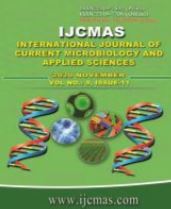


 National Academy of Agricultural Sciences (NAAS)
National Academy of Agricultural Sciences (NAAS)

|
PRINT ISSN : 2319-7692
Online ISSN : 2319-7706 Issues : 12 per year Publisher : Excellent Publishers Email : editorijcmas@gmail.com / submit@ijcmas.com Editor-in-chief: Dr.M.Prakash Index Copernicus ICV 2018: 95.39 NAAS RATING 2020: 5.38 |
Okra, Abelmoschus esculentus, is being grown from February to July months under varying weather conditions in Haryana, so the present investigation was done to examine the life cycle and development of root-knot nematode (Meloidogyne javanica) in three different growing seasons i.e. spring (March to April), summer (May to June) and monsoon (July to August). These experiments were conducted under screen house conditions of Department of Nematology, CCS Haryana Agricultural University, Hisar. The significant difference was observed in developmental stages and completion of life cycle period of M. javanica under different growing seasons. The observations for developmental stages were recorded at initial three days for penetration and after that three days interval for subsequent stages. The penetration of infective juveniles (J2) was activated within 24 hours in summer and monsoon season while it started in 72 hours at lower temperature during spring season. Swelling of infective stage (J2) of M. javanica was started from 3rd days in summer and monsoon seasons while in spring season it was observed on seventh day after inoculation. The spike tail stages i.e. J3 and J4, were observed up to twelve days of inoculation during spring and monsoon seasons while eight days were taken during summer season due to variation in temperature and relative humidity. During spring, summer and monsoon seasons, M. javanica completed its one generation in 35, 27 and 31 days at average atmospheric temperature of 24.3°C, 33°C and 29.5°C respectively which occurred during the experiments. Thus, the development and life cycle of M. javanica was observed as dependent on weather parameters under same susceptible crop variety which were directly or indirectly correlated with growing seasons.
 |
 |
 |
 |
 |